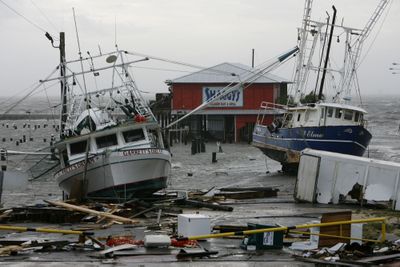Gustav soaks Gulf Coast
New Orleans spared repeat of disaster

NEW ORLEANS – Hurricane Gustav scoured rural southern Louisiana on Monday with blistering winds and dangerous storm surges, but New Orleans weathered its latest encounter with natural disaster, emerging with a strained levee system that mostly held after a tense day of uncertainty.
Plowing in from the Gulf of Mexico across coastal lowlands dominated by oil pipelines and fishing wharves, Gustav quickly weakened west of New Orleans, spinning through the state’s central peninsula toward east Texas.
Even as Gustav moved into Louisiana’s interior, Hurricane Hanna was forming over the Bahamas. National Hurricane Center forecasters predicted that the new storm could reach the southeastern U.S. by midweek.
By day’s end, New Orleans clearly had escaped a catastrophic replay of the destruction left by Hurricane Katrina three years ago. The unprecedented mass evacuation of 1.9 million people emptied the hurricane zone and appeared to have spared the region from heavy casualties.
Despite winds that gusted above 60 mph and sent rain slanting sideways, the evacuated city avoided heavy structural damage.
Public officials remained guarded in their assessments as the day passed, but grew increasingly optimistic that the city had missed the brunt of the storm. A relaxed New Orleans Mayor Ray Nagin said Monday night that he felt “really good” about the city’s status.
“The City of New Orleans is not totally out of the woods, but we’re getting close,” he said, adding that today would be “a day of repair and assessment.”
Major companies probably would be allowed to return Wednesday in preparation for a repatriation of the city’s evacuated populace. “Re-entry is only days away, not weeks away,” Nagin said.
Authorities reported eight deaths related to the storm, including four people who were killed in Georgia when their car struck a tree as they attempted to flee the storm.
A 27-year-old Lafayette, La., man was killed when a tree fell on his house as the storm whipped through, and an Abbeville, La., couple were killed when a tree fell on a home in Baton Rouge. Before arriving in the U.S., Gustav was blamed for at least 94 deaths in the Caribbean.
The storm that crashed ashore as a Category 2 hurricane had by late Monday been downgraded to a tropical storm with maximum sustained winds of 60 mph.
The city’s most anxious moments came as floodwater streamed over levee walls along the Industrial Canal, the artery that connects the Mississippi River with Lake Pontchartrain.
The canal’s levee walls overflowed in two spots, and floodwaters seeped into the low-lying streets of New Orleans’ Upper Ninth Ward – scene of major flooding three years ago from Hurricane Katrina.
But by 3 p.m., a National Guard team making spot checks on the canal reported that water levels had dropped nearly 2 feet since morning, a welcome hint that the worst of Gustav’s storm surge had passed.
“It’s dropped at least 18 inches, if not 2 feet,” said Louisiana National Guard Lt. Col. Freddy Morris, commander of 256th Special Troop Battalion. Morris led a team that inspected the levee walls and water levels. “I’m feeling a little better.”
After monitoring southern Louisiana levees for much of the day, U.S. Army Corps Engineer officials expressed cautious optimism that the major repairs they had begun after Katrina had held. More than 350 miles of federal levees protecting the city were spared the devastating failures that plagued the floodwalls three year ago.
“The system proved resilient,” said Maj. Elizabeth Robbins, a Corps spokeswoman.
South of New Orleans, a sodden levee along a bend in the Mississippi River near the town of Braithwaite breached just before dusk, threatening several dozen riverbank houses. The floodwall, in Plaquemines Parish, is not part of the federal levee system.
But by nightfall, they were making headway. Dan Ragas, a parish equipment operator, said levee workers would firm up the floodwalls if it took all night. “Look around,” gesturing to the small army of men in mud-spattered boots. “These people are out there making it happen.”
Gustav roared into the mainland about 70 miles southwest of New Orleans near the small coastal town of Cocodrie just after 10 a.m., the National Hurricane Center in Miami reported. Barreling in across the heartland of the state’s Cajun population, the hurricane spun off gusts in excess of 95 mph as it tore through the oil industry communities of Houma, Thibodaux and Morgan City.